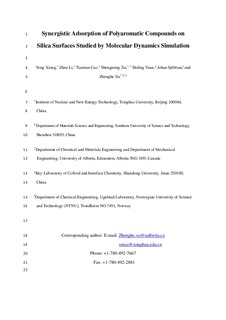| dc.contributor.author | Xiong, Yong | |
| dc.contributor.author | Li, Zhen | |
| dc.contributor.author | Cao, Tiantian | |
| dc.contributor.author | Xu, Shengming | |
| dc.contributor.author | Yuan, Shiling | |
| dc.contributor.author | Sjøblom, Johan | |
| dc.contributor.author | Xu, Zhenghe | |
| dc.date.accessioned | 2019-03-14T12:09:50Z | |
| dc.date.available | 2019-03-14T12:09:50Z | |
| dc.date.created | 2018-12-10T14:59:13Z | |
| dc.date.issued | 2018 | |
| dc.identifier.citation | Journal of Physical Chemistry C. 2018, 122 (8), 4290-4299. | nb_NO |
| dc.identifier.issn | 1932-7447 | |
| dc.identifier.uri | http://hdl.handle.net/11250/2590025 | |
| dc.description.abstract | Adsorption on silica surfaces of polyaromatic compounds, N-(1-hexylhepyl)-N′-(5-carboxylicpentyl)-perylene-3,4,9,10-tetracarboxylic bisimide (C5Pe) and N-(1-undecyldodecyl)-N′-(5-carboxylicpentyl)-perylene-3,4,9,10-tetracarboxylic bisimide (C5PeC11), individually and their binary mixture in heptol (mixture of heptane and toluene as oil) solutions were studied by molecular dynamics (MD) simulation, quartz crystal microbalance with dissipation (QCM-D), and atomic force microscopy (AFM). The MD simulation results showed that C5Pe molecules tend to aggregate and form a large cluster rapidly in the oil phase, reducing the energy of the system. In contrast, C5PeC11 molecules with higher solubility tend to disperse in the system. As a result, C5PeC11 molecules exhibited a stronger adsorption than C5Pe molecules on silica surfaces. In the binary mixture system, the overall solubility is only slightly lower than that in the C5PeC11 system due to the association of C5Pe with C5PeC11 molecules through π–π stacking and T-stacking interactions, leading to more polyaromatic compounds available for adsorption onto silica surfaces. The enhanced adsorption of both polyaromatic compounds on silica surfaces clearly illustrates the synergy of adsorption in the mixed systems of C5Pe and C5PeC11 as compared with the systems of their individual species. The adsorption characteristics revealed in MD simulations were confirmed by QCM-D measurement and AFM imaging. The observed synergy of adsorption provides insights into molecular assembly at silica–oil interfaces for the fabrication of devices or sheds lights on petroleum processing. | nb_NO |
| dc.description.abstract | Synergistic Adsorption of Polyaromatic Compounds on Silica Surfaces Studied by Molecular Dynamics Simulation | nb_NO |
| dc.language.iso | eng | nb_NO |
| dc.publisher | ACS Publications | nb_NO |
| dc.relation.uri | https://pubs.acs.org/doi/abs/10.1021/acs.jpcc.7b10907 | |
| dc.title | Synergistic Adsorption of Polyaromatic Compounds on Silica Surfaces Studied by Molecular Dynamics Simulation | nb_NO |
| dc.type | Journal article | nb_NO |
| dc.type | Peer reviewed | nb_NO |
| dc.description.version | acceptedVersion | nb_NO |
| dc.source.pagenumber | 4290-4299 | nb_NO |
| dc.source.volume | 122 | nb_NO |
| dc.source.journal | Journal of Physical Chemistry C | nb_NO |
| dc.source.issue | 8 | nb_NO |
| dc.identifier.doi | 10.1021/acs.jpcc.7b10907 | |
| dc.identifier.cristin | 1641249 | |
| dc.description.localcode | © Copyright 2018 American Chemical Society. This is the authors accepted and refereed manuscript to the article. Locked until 25 January 2019 due to copyright restrictions. | nb_NO |
| cristin.unitcode | 194,66,30,0 | |
| cristin.unitname | Institutt for kjemisk prosessteknologi | |
| cristin.ispublished | true | |
| cristin.fulltext | original | |
| cristin.fulltext | postprint | |
| cristin.qualitycode | 1 | |
